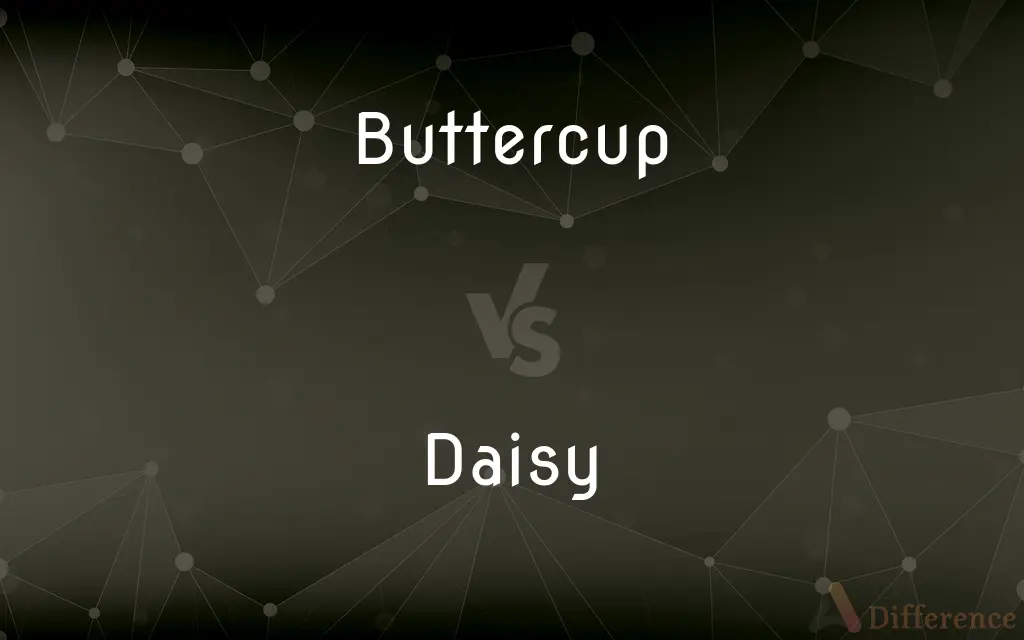Buttercup vs. Daisy — What's the Difference?
By Tayyaba Rehman & Urooj Arif — Updated on March 17, 2024
Buttercups are known for their glossy, yellow flowers, while daisies are recognized by their white petals and yellow centers.

Difference Between Buttercup and Daisy
Table of Contents
ADVERTISEMENT
Key Differences
Buttercups, belonging to the genus Ranunculus, are characterized by their shiny, yellow petals that often contribute to their visual appeal in wild and garden settings. On the other hand, daisies, which are part of the Asteraceae family, feature a classic look with white petals surrounding a bright yellow center, symbolizing purity and innocence.
Buttercups tend to thrive in moist environments and are often found near water bodies. They possess a unique glossy sheen, attributed to the layer of reflective cells beneath the petal surface. Whereas daisies are more adaptable, growing in a variety of conditions from lawns to roadsides, showcasing their resilience and versatility.
The flowers of buttercups are usually solitary on a single stem, making them stand out individually in their natural habitat. While daisies often grow in clusters, creating a carpet of white and yellow that covers the ground, enhancing their communal beauty.
Buttercups contain a compound called ranunculin, which can be toxic to livestock and humans if ingested, serving as a natural deterrent to grazing. Conversely, daisies are generally considered safe and have been used in traditional medicine for various ailments, reflecting their benign nature.
Buttercups are often associated with childish games, such as holding the flower under the chin to see if there’s a yellow reflection, indicating a liking for butter. Daisies, however, are linked to innocence and loyalty, often featured in literature and folklore as symbols of purity.
ADVERTISEMENT
Comparison Chart
Family
Ranunculaceae
Asteraceae
Flower Color
Yellow
White petals with a yellow center
Habitat
Moist environments, near water
Various, including lawns and roadsides
Growth Habit
Solitary flowers
Clusters of flowers
Usage
Mostly ornamental, some toxic properties
Ornamental and medicinal uses
Compare with Definitions
Buttercup
Known for its glossy petals that reflect light.
The buttercup’s shine is due to its unique cell structure.
Daisy
Associated with loyalty and love.
He gave her a daisy to symbolize his undying loyalty.
Buttercup
Can be toxic if ingested.
Farmers beware; buttercups in pastures can poison livestock.
Daisy
Often used in traditional medicine.
Daisies have been used for centuries in herbal remedies.
Buttercup
Prefers moist environments for growth.
Buttercups flourish alongside the stream in our backyard.
Daisy
Grows in a variety of conditions.
The resilience of daisies allows them to thrive almost anywhere.
Buttercup
A bright, yellow-flowered plant of the genus Ranunculus.
The field was dotted with the glossy yellow of buttercups.
Daisy
A common wildflower with white petals and a yellow center.
Daisies covered the lawn, creating a stunning white and yellow carpet.
Buttercup
Symbolizes childishness and joy.
Playing the buttercup game brought back childhood memories.
Daisy
Symbolizes innocence and purity.
The bouquet of daisies was chosen for its symbol of purity.
Buttercup
Any of numerous herbs of the genus Ranunculus, native chiefly to temperate and cold regions and having acrid juice, often toothed or lobed leaves, and usually yellow or white flowers with numerous pistils.
Daisy
A widely naturalized Eurasian plant (Leucanthemum vulgare syn. Chrysanthemum leucanthemum) having flower heads with a yellow center and white rays. Also called oxeye daisy, white daisy.
Buttercup
Any of many herbs, of the genus Ranunculus, having yellow flowers; the crowfoot.
Daisy
A low-growing plant (Bellis perennis) native to Europe and widely naturalized, having flower heads with white or pinkish rays. Also called English daisy.
Buttercup
Any flower of the genus Narcissus; a daffodil.
Daisy
The flower head of any of these plants.
Buttercup
Affectionate or ironic term of address.
Daisy
(Slang) One that is deemed excellent or notable.
Buttercup
A plant of the genus Ranunculus, or crowfoot, particularly Ranunculus bulbosus, with bright yellow flowers; - called also butterflower, golden cup, and kingcup. It is the cuckoobud of Shakespeare.
Daisy
A wild flowering plant Bellis perennis of the Asteraceae family, with a yellow head and white petals
Buttercup
Any of various plants of the genus Ranunculus
Daisy
Many other flowering plants of various species, mostly among the asterids.
Daisy
(Cockney rhyming slang) A boot or other footwear.
Daisy
A genus of low herbs (Bellis), belonging to the family Compositæ. The common English and classical daisy is Bellis perennis, which has a yellow disk and white or pinkish rays.
Daisy
Any of numerous composite plants having flower heads with well-developed ray flowers usually arranged in a single whorl
Common Curiosities
What colors do buttercups come in?
Buttercups are primarily yellow.
Can buttercups grow in dry conditions?
Buttercups prefer moist conditions and may not thrive in dry environments.
Are daisies edible?
Yes, some parts of daisies are edible and used in traditional medicine.
Do daisies bloom all year round?
Daisies can bloom in multiple seasons, but their peak is in spring and summer.
What does a daisy symbolize?
Daisies symbolize innocence, purity, and loyalty.
Are buttercups good for gardens?
While beautiful, buttercups can be toxic and should be planted with caution.
Is it easy to grow buttercups?
Yes, buttercups are relatively easy to grow in suitable moist conditions.
What is the main difference in the habitat preferences of buttercups and daisies?
Buttercups prefer moist environments, whereas daisies can thrive in a variety of conditions.
How long do daisy flowers last?
Daisy flowers can last several days when cut and placed in water.
Can you be allergic to buttercups?
Yes, some people may have skin reactions to buttercups.
How do daisies adapt to their environment?
Daisies are highly adaptable and can grow in a wide range of conditions.
Do daisies attract wildlife?
Yes, daisies can attract bees, butterflies, and other pollinators.
What are the common uses of buttercups?
Buttercups are primarily ornamental, though some species have medicinal or cultural uses.
Can buttercups be used in medicine?
Due to their toxicity, buttercups are not commonly used in medicine.
How do buttercups and daisies differ in their growth habits?
Buttercups grow as solitary flowers on single stems, while daisies often grow in clusters.
Share Your Discovery

Previous Comparison
Trunk vs. Suitcase
Next Comparison
Bluff vs. BlusterAuthor Spotlight
Written by
Tayyaba RehmanTayyaba Rehman is a distinguished writer, currently serving as a primary contributor to askdifference.com. As a researcher in semantics and etymology, Tayyaba's passion for the complexity of languages and their distinctions has found a perfect home on the platform. Tayyaba delves into the intricacies of language, distinguishing between commonly confused words and phrases, thereby providing clarity for readers worldwide.
Co-written by
Urooj ArifUrooj is a skilled content writer at Ask Difference, known for her exceptional ability to simplify complex topics into engaging and informative content. With a passion for research and a flair for clear, concise writing, she consistently delivers articles that resonate with our diverse audience.















































